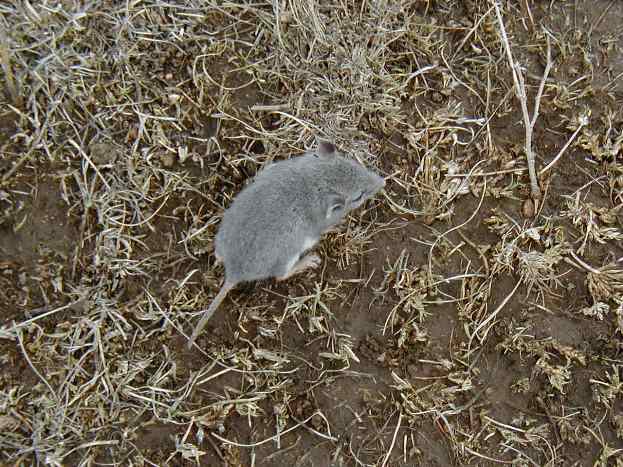Wild Pantex – One Tough Ole Mouse
Article by Jim Ray, Pantex Wildlife Biologist/Scientist
Recently a Pantexan couple were fortunate enough to see and photograph a strange mouse at their new home in my neighborhood north of Canyon. This mouse was “different” in that it had a very short tail. Their visitor was one of the most unique mammals in our area, and I was impressed that my neighbors had already properly identified it as a grasshopper mouse.
Our local grasshopper mouse is the northern grasshopper mouse. It is found in our prairies and I first became acquainted with them while trapping for my Mammalogy collection while a student at Texas Tech. I found them to be an easy catch in the grasslands and playa edges around my hometown of Dalhart. Evidently, they have a fondness for peanut butter, as do most mice.
The northern grasshopper mouse is found in western North America from southwestern Canada into northwestern Mexico. This is a stoutly-built mouse, with a short tail that is less than one-third of its body length. Its color is drab brown to reddish brown, with white underparts. Its short tail stands out, causing the mouse to resemble a hamster.
So, besides its short tail, what makes this animal so unique? First off, this mouse is a predatory species, subsisting off of a diet that includes insects and other invertebrates, as well as mice, reptiles, and even grassland birds. NO FOOLING! Additionally, this animal has a well-known vocalization that resembles a scream or a howl. It is believed that it is given while hunting as well as for territorial reasons. During this process, the mouse stands on its hind legs, throws its head back, and gives it all he/she has.
Here is a recording of a grasshopper mouse vocalizing, which I can attest to, is a common sound at night in the grasslands of Pantex!
Pantex and Texas Tech University actually has some pretty good data on grasshopper mice. During two different research projects that looked at what wildlife species utilize prairie dog colonies versus prairie without prairie dogs, Texas Tech and Pantex discovered that the grasshopper mouse was more abundant, by far, in prairie dog colonies than in prairie not occupied by prairie dogs. In fact, they were the only small mammal species that showed a strong relationship to prairie dog colonies. No doubt, the burrows of prairie dogs and the preponderance of ground-dwelling insects that we also found to be highest on prairie dog colonies, make these areas attractive habitat to this species. BTW, when captured these guys smell horrible, a likely tactic used to get an occasional predator to drop him.
Here is an interesting statistic for you! The number one predator of a well-studied population of Texas horned lizards in South Texas is…you guessed it – the northern grasshopper mouse! This may explain why we find fewer than expected horned lizards in the very promising-looking habitat (for horned lizards) found in prairie dog colonies at Pantex. The question is, is this because of predation by grasshopper mice (and burrowing owls??) or are our Panhandle horned lizards programmed to avoid this predation by avoiding prairie dog colonies?
So, next time you are out on the prairie at night, listen for the howling of grasshopper mice. Perhaps, before, you assumed it was a bird. Now you know that it was one tough ole mouse!

Photo: A northern grasshopper mouse at Pantex. The gray coloration shows that this is an older individual.
